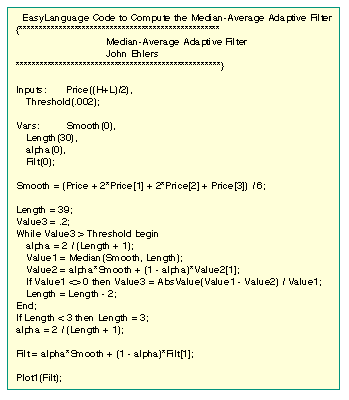The Secret Behind The Filter
What's The Difference?
What's the difference between the median and the average? It's what drives this new adaptive smoothing filter.
Remember back in school when your teacher asked you what the difference was between the median and the average? I remember thinking, "Yeah, what is the difference?" as in, "Who cares?" As it turns out, you should care. It is exactly that difference that drives a unique new adaptive smoothing filter that I'm going to tell you about.
Average and median filters eliminate extraneous data in fundamentally different ways. An average folds "noise" in with the signal so that if enough points are selected, the noise is reduced by summing to its own (nearly) zero average value. On the other hand, a median filter eliminates noise by ignoring it. A big spike in the data has no impact at all on the median signal value. Median filters are used in video to eliminate impulsive, or "salt and pepper" noise on the picture. We will exploit these characteristics to create an adaptive smoothing filter.
THE DIFFERENCE IS...
Consider a dataset that consists of 10 ones. Both the average and the median of this dataset is 1. Next, let's move that dataset forward as we would with a moving average, dropping the last old data sample and adding a new one. Assuming the value of the new data sample is 10, then the new average will be 1.9 (nine ones and one 10, divided by 10). On the other hand, the median of the new dataset still remains unchanged at 1. A median filter ranks all the samples within the filter and selects the middle one as the filter output. So there is a difference between median and averaging filters. That percentage difference becomes less as the respective filter lengths are made shorter.

FIGURE 1: EASYLANGUAGE CODE TO COMPUTE THE MEDIAN-AVERAGE ADAPTIVE FILTER
Excerpted from an article originally published in the March 2005 issue of Technical Analysis of STOCKS & COMMODITIES magazine. All rights reserved. © Copyright 2005, Technical Analysis, Inc.
Return to March 2005 Contents